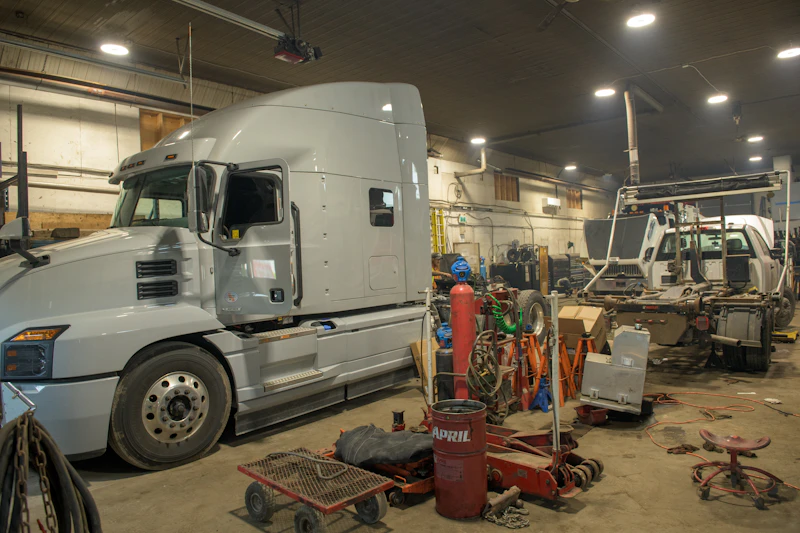Understanding Air Brakes in Heavy-Duty Trucks

Ever wondered how the brakes in heavy-duty trucks are able to bring thousands of pounds of freight and machinery to a halt? When it comes to the safety and reliability of your heavy-duty truck, having a deep understanding of the braking system is important not only for your safety but the safety of others. In this comprehensive blog post, we will delve into the intricate workings of air brakes, exploring how they work, the role of each of their components, advantages over hydraulic brakes, and preventive maintenance tips.
What Are Air Brakes?
Air brakes are a sophisticated and powerful braking system employed in heavy-duty trucks. Unlike hydraulic brakes, which rely on fluid pressure, air brakes utilize compressed air to operate. One of the key elements of air brakes is the triple-valve principle, which facilitates the sequential operation of braking events. The triple valve comprises three chambers that work in unison to control the application and release of brakes.
The components that make up an air brake system include:
- Compressor: Responsible for pressurizing the air to power the braking system.
- Air storage tanks: Store compressed air to ensure an adequate supply for braking functions.
- Brake pedal: When pressed, it sends a signal to the brake chamber to release air and engage the brakes.
- Brake chambers: Convert the air pressure into mechanical force, applying the brakes.
- Slack adjusters: Maintain proper tension on the brake pads, ensuring optimal braking performance.
- Brake S-cam: A cam with an S-shaped profile that pushes brake shoes apart, thereby pressing on brake drums
- Push Rod: Steel rod that connects the brake chamber and the slack adjuster, similar to a piston. If extended, the brakes are applied.
- Brake drums and shoes: Create the friction needed to bring the vehicle to a stop.
How Air Brakes Work
Understanding the working of air brakes is essential to grasp their efficiency and reliability. When the driver presses down on the brake pedal, it sends a signal to the brake chambers, causing the compressed air to be released. The released air travels through airlines and the various components across your air brake system, applying force to the brake shoes and causing them to press against the brake drums. The brake shoes pressing on the brake drums generate friction, which ultimately slows down the heavy-duty truck. To release the brakes, the driver releases the brake pedal, allowing air pressure to equalize and retracting the brake shoes from the drums.
Why Are Air Brakes Used in Heavy-Duty Trucks?
Air brakes are the go-to choice for heavy-duty trucks due to several reasons. One primary advantage is their ability to handle the high braking demands of heavy loads. Heavy trailers equipped with their own brakes can be seamlessly integrated into the air brake system, allowing drivers to stop promptly and safely. Unlike hydraulic systems, which can be impractical in such scenarios, air brakes offer superior control and performance, ensuring the safety of both the truck and its cargo.
But that's not all! Air brakes offer other advantages over hydraulic systems in heavy-duty applications. They exhibit enhanced heat dissipation, allowing them to withstand high braking temperatures without losing effectiveness. Additionally, air brakes provide smoother and more consistent braking performance, which is important when an 80,000-pound truck carrying a full load needs to come to a smooth stop. These qualities make air brakes the go-to choice for fleet managers and truck owners, providing peace of mind and reliability on the road.
Air Brakes: Preventive Maintenance Tips
To ensure the longevity and optimal performance of your air brake system, a proactive approach to preventive air brake maintenance is crucial. Here are some essential tips to keep your air brakes in top shape:
- Regular Inspections: Conduct routine inspections of your air brake system, checking for leaks, damaged components, and proper air pressure.
- Brake Adjustment: Properly adjust your brake slack adjusters to maintain the optimal tension between the brake shoes and drums. This ensures consistent braking performance and maximizes the lifespan of brake components.
- Air System Checks: Regularly examine the air storage tanks, valves, and lines for any signs of wear or damage. Ensure proper air pressure levels and address any abnormalities promptly.
- Moisture Control: Moisture is the enemy of any air brake system. Install air dryers and moisture traps to prevent water accumulation, which can lead to corrosion and compromised brake performance.
- Training and Education: Stay informed about the latest industry practices and advancements in air brake technology. Train your drivers on proper braking techniques and the importance of regular system inspections.
Remember, preventive maintenance is the lifeline of your air brake system, safeguarding your truck and everyone on the road.
Final Words
When it comes to running a safe operation, understanding the intricacies of air brakes is crucial for fleet managers and truck owners alike. The reliable and efficient operation of air brakes ensures the safety and smooth functioning of your heavy-duty truck for both you and other people on the road. By comprehending the several components of air brakes, the working mechanism, and the maintenance requirements, you can optimize the performance and longevity of your air brake system.
At Saviors Repair, we specialize in the maintenance and repair of air brake systems for heavy-duty trucks. Our skilled technicians are well-versed in the complexities of air brakes and equipped with the latest tools and expertise to keep your fleet on the road. Contact us today to schedule an appointment or to learn more about our comprehensive truck repair services. Remember, when it comes to air brakes, knowledge is power!


.webp)
.webp)